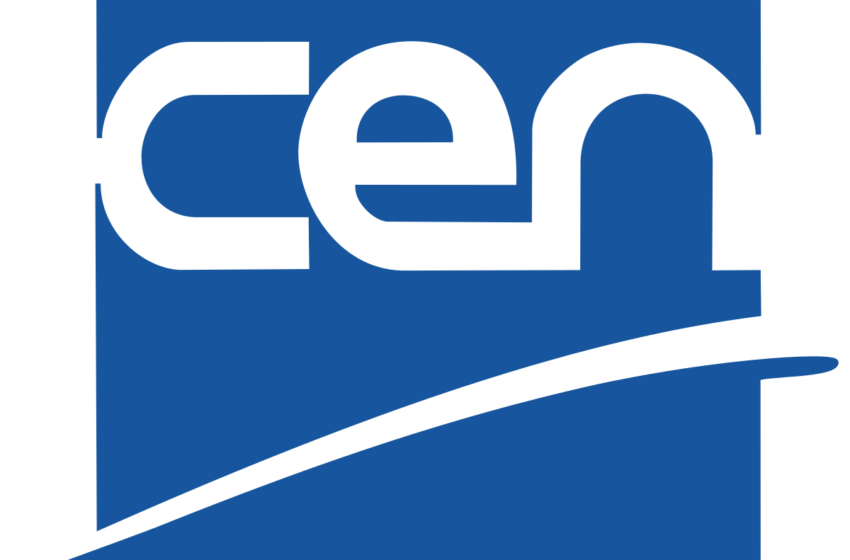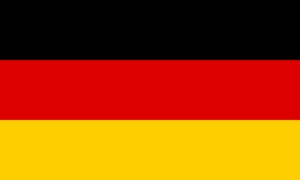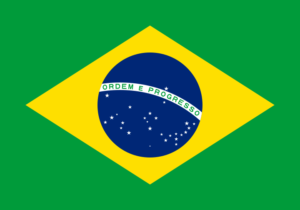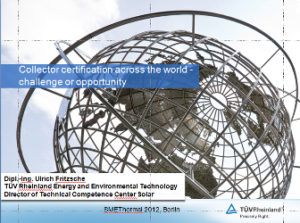Worldwide: Final Draft of New Collector Standard
May 23, 2013
The draft of the EN ISO 9806 was submitted to the CEN/TC 312 in January 2013. This means that all technical debates are concluded and only minor editorial changes may still find their way into the latest version. The formal voting will take place in June and August 2013, and the new standard is said to be published between February and May 2014. The EN ISO 9806 replaces the EN 12975-2 and the ISO 9806-1, -2 and -3. It will be the first almost globally valid standard for solar thermal collectors, as it is both an EN and an ISO standard.
As an EN standard, the EN ISO 9806 will become the relevant document for collector tests in all 33 member states of the European Committee for Standardization (CEN). By the time it enters into force, all national standards for the member states which are not in line with the new European standard will be withdrawn. The standards of the International Organization for Standardization (ISO) are effective worldwide and have a high reputation, but do not necessarily become a national standard outside the CEN countries.
The new EN ISO 9806 standard will change the description of the following technical procedures:
- Testing procedures for air collectors will be similar to Canadian standard “CSA F378.2, Air heating solar collectors – Test methods“. For example, leakage testing for air collectors will differ from the testing procedure for fluid collectors. The new standard also includes different tests for closed-loop and open-loop air collectors.
- There will be more precise instructions on how to test concentrating and tracking collectors. The experience of the ITW/TZS Stuttgart was an important resource for these tests. Some of the new instructions are very basic ones: For example, the EN ISO 9806 draft defines that the performance has to be measured through the quasi-dynamic test method and not the steady-state one. In contrast to the steady-state method, the quasi-dynamic test distinguishes between direct and diffuse irradiation, which is a very relevant parameter because only direct radiation can be concentrated. The standard also states that if the collector is delivered with a tracking system, this tracking system has to be used in the tests, in order to represent the product adequately. Some boundary conditions for the tests have been specified as well, such as the acceptable irradiation angle for single-axis tracking systems. The annex, on the other hand, describes the new durability and reliability tests. For example, many concentrating collectors have safety mechanisms which defocus the collector if stagnation is causing the system to overheat – the new annex includes a procedure to test exactly these mechanisms.
- So far, PVT collectors have not been included in the standard. But there is already a so-called extended scope, which means that they may be included later in a second part of the standard.
- Fluid-based collectors will see some changes in their testing procedures compared to EN 12975-2. The new standard regards the collector gross area as the relevant reference for all area-specific data, e.g., the yield per area. Until now, the reference used in Germany has been the aperture area, which has presented some difficulties in comparing collector data on an international basis.
- The rain penetration test will be modified. According to the EN 12975-2, all exposed areas were to be irrigated. In the future, the rain penetration test will focus more on edges and corners, including a detailed description of positions and angles of the used nozzles.
- The exposure test will be quicker in the future, due to changed climate reference data. The EN 12975-2 demanded a minimum of 30 days of outdoor exposure with a minimum daily global irradiation of 14 MJ/m2 on every single day (this and all following figures refer to irradiation on collector plane). This could significantly prolong testing procedures in Central Europe’s climate. The EN ISO 9806 requires 30 days of exposure in total and a total minimum of 420 to 600 MJ/m2, depending on the climate at the test site. Within these 30 days, a minimum global irradiation of 850 to 1050 W/m2 has to be reached during at least 30 hours of the test.
The above-mentioned standards describe how to carry out the testing procedures and how to write the corresponding test reports. They, however, do not specify how to design the data sheets and do not specify requirements for certifications, such as the Solar Keymark does for Europe. The organisation to set Solar Keymark requirements is the Solar Keymark Network, which meets twice a year and is made up of experts from the solar thermal industry, testing institutes and certification bodies. Certifications are often based on standards, in order to gain data coherence and reduce testing efforts. An example for a specific Solar Keymark requirement is the second table found on each collector certificate. It shows the performance of collectors in various cities in Europe and has been part of the certification since 2011. Once the new standard is published, it will be the reference for future Solar Keymark certifications. Then, it will be the job of the Solar Keymark network to define transition periods for the validity of the certificates issued based on the former standard.
To stay up-to-date about the publication of new standards, you can subscribe to the news service of the respective standardisation body.
More information:
http://www.cen.eu
http://www.din.de
http://www.iso.org
http://www.itw.uni-stuttgart.de
Users can register on http://www.entwuerfe.din.de to read and comment on drafts for future DIN standards (for Germany)


